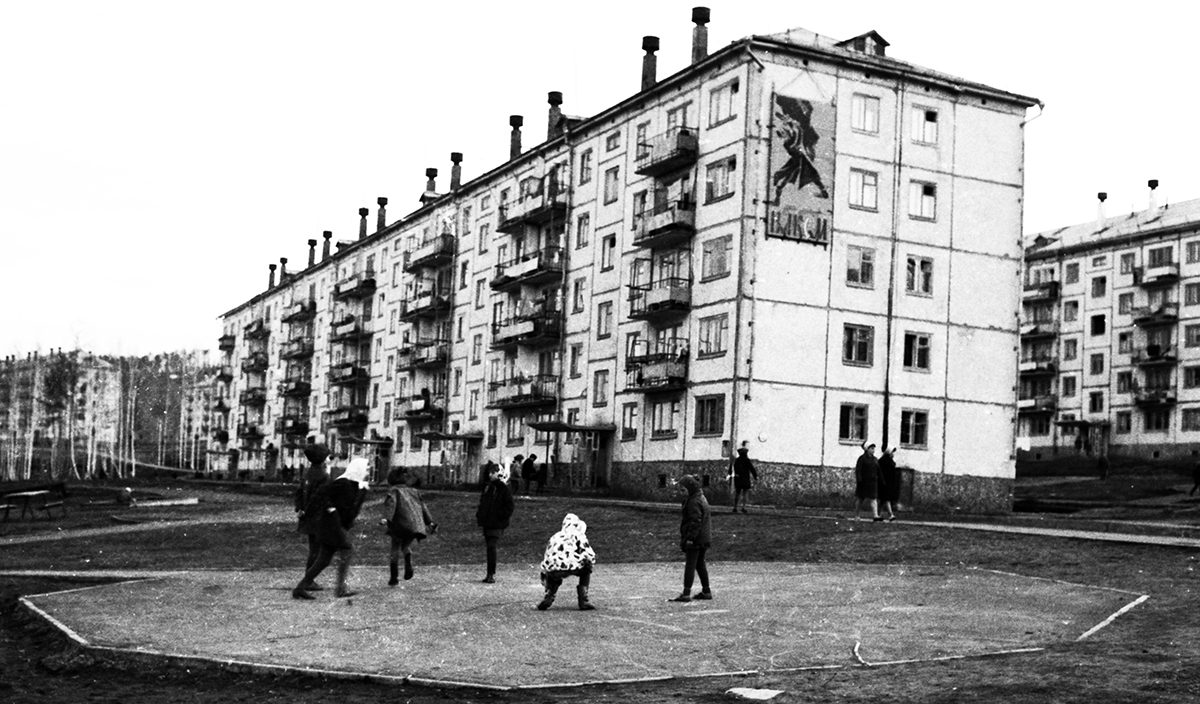Незнакомые смотрят волками,
И один из них, может быть, я.
—Борис Гребенщиков
Strangers glare like wolves,
And I might be one of them.
—Boris Grebenshikov
The Democrat vice presidential nominee Tim Walz entered the national scene with a passive-aggressive endorsement of government-run economic activity. “One person’s socialism,” the Minnesota governor quipped, “is another person’s neighborliness.”
It’s easy for Walz to talk like that, living in a nation where markets allow for an unprecedented accumulation of wealth, food is plentiful, and citizens are comfortable in their standalone suburban homes. Having grown up in Soviet Ukraine, however, I happen to know that socialism does not encourage neighborliness.
First, there is the issue of socialist neighborhoods themselves. In the decades following the 1917 Bolshevik Revolution, Soviet leadership forcefully industrialized the backward and rural Russian Empire. The process was as murderous as it was successful: in the few short years of collectivist agriculture, Joseph Stalin diverted food from the countryside to the cities, starving millions. The Holodomor propelled the movement of farmers into urban centers where the USSR scrambled to create factory jobs. Because central planners neglected to design urban areas that would be ready to receive the inflow, the new arrivals ended up clustered in crowded kommunalkas, or communal apartments. It was not unusual for multiple families to share a room, and the number of rooms per apartment could be in the double digits. Some even slept under staircases, Harry Potter–style.
Because amenities were shared, unrelated people got to know each other intimately, with all five senses. Sometimes these accidental roommates formed close bonds, but more frequently they rubbed each other the wrong way. And they continued rubbing their bleeding wounds until one of the residents lucked out with an individual apartment—housing waiting lists were decades-long—or passed away.
The exiled Russian poet and Nobel laureate Joseph Brodsky recalled, with a whiff of sorrowful adulation, the education in human nature imparted to him by the intensity of a kommunalka kitchen:
This is where one learns life’s essentials: by the rim of one’s ear, with the corner of one’s eye. What silent dramas unfurl there when somebody is all of a sudden not on speaking terms with someone else! What a school of mimics it is! What depth of emotion can be conveyed by a stiff, resentful vertebra or by a frozen profile! What smells, aromas, and odors float in the air around a hundred-watt yellow tear hanging on a plait-like tangled electric cord. There is something tribal about this dimly lit cave, something primordial—evolutionary, if you will; and the pots and pans hang over the gas stoves like would-be tom-toms.
The housing question plagued the USSR for all its short life. The most ambitious attempt at solving it was the khrushchevka, the shoddy (and identical) five-story concrete apartment boxes erected across the immense Soviet expanses starting in the 1960s. They were named after Nikita Khrushchev, who rose to power after Stalin’s demise and whose wide-ranging reforms included this makeshift solution to the housing crisis.
A slight improvement on khrushchevkas were brezhnevkas. Named after the next leader, Leonid Brezhnev, these mid-rises were taller and had more variation in design. They were thrown up in different locations around the country, often in the middle of nowhere. Those paying close attention to the Russo-Ukrainian war probably noted the footage of destroyed villages in eastern Ukraine that, in their glory days, consisted entirely of a handful of brezhnevkas. I’m not going to say that this architectural style was developed for national defense purposes, but it did make for formidable fortresses.
The urban density of the Soviet variety far exceeded that found among New York brownstones. These veritable ant farms existed under constant surveillance of prematurely aged, frequently widowed women who held court on the benches of every backyard. Babushkas inspired awe and pity. They gossiped prodigiously, taking note of every transgression, and scolded strangers at will. They paid particular attention to romantic affairs, substance use, and affectations of young people, as well as parenting skills of new mothers and who may have had an abortion. Their stationary morality patrols had utility, but don’t kid yourselves—Communist ideology gave birth to a very rigid, and densely populated, social arrangement.
The longing for privacy under socialism, for the sheer freedom to “mind your own damn business,” as Walz put it in his abortion speeches, was enormous. Babushkas were resented, but they were an essential feature of the Soviet heartland. We have our own variety of babushka, by the way—we call them Karens, the best that a consumer economy can produce.
Because of the housing shortage, neighborhoods were poorly sorted by age and lifestyle—people took apartments where they could. Children and young adults often find dorm-like proximity to peers exhilarating, but Soviet living arrangements were multigenerational. The younger residents wanted to make noise, and that’s understandable, but they were surrounded by working parents and seniors with a myriad of health problems who just needed some quiet. The two latter types didn’t feel shy about knocking on the wall or ringing the bell should loud sounds come out of a nearby apartment—and while they were at it, they would relay their entire catalogue of complaints to the noise-makers.
Sharing a flat with a girlfriend contra the tangible hate expressed by his neighbors was the topic of a track by the Russian underground star Alexander Bashlachev. He sang:
When we are finally alone
We quickly turn off the lights
And are never bored
May the neighbors forgive us
For the night-long ringing
of the spoon
In the tea cup.
It was bad enough if people living above, below, to the left, and to the right were sensitive to noise—or invented complaints against their weird neighbors that were at once wild and trivial. But one also had a ear out for substantial conversations that could be overheard.
In Stalin’s time, Soviet subjects were known to rat out their kommunalka neighbors to NKVD to get a better room in communal apartments once the “enemies of the people” were disappeared. After the roach-mustached despot was gone, security apparatus remained in place and people were perpetually wondering who among them may be a stukach, or the snitch.
My late father was an engineer by profession, but he was also an artist and a writer; one of his plays was staged in children’s theaters across the USSR. He attended a writers’ workshop and was good friends with one of its regulars, Uncle Grisha. Although my grandmother took an instinctual dislike to him, Grisha became one of my dad’s closest friends. They’d hang out regularly, and sometimes we went on vacations together. Then in the mid-’80s, their friendship suddenly came to a halt, and after my father’s passing my mother explained that the close family friend turned out to be KGB. My father never divulged how he found out; it was too painful an issue.
A writers’ workshop was precisely the place where the internal security apparatus is expected to spread its tentacles, but its presence was presumed to be everywhere. Strangers looked at each other with suspicions—and so did friends.
The empty shelves of Soviet stores is where the socialist neighborliness found its most pure, most notorious expression, however. Where suppliers don’t compete for customers, customers compete over the scarce products. Lines to buy basic goods were long and mean. Exhausted, aggressive shoppers screamed at each other, and fights were a common sight—not necessarily full-blown riots, but close. Drunk on power, sales ladies insulted shoppers. They held the best merchandise behind for their friends and family; everyone knew it.
Consumers formed their own distribution networks called blat that allowed for the purchase or exchange of coveted products. Because the ability to procure necessary goods depended on strong personal connections, friendships were formed early and were expected to last a lifetime. Nevertheless, it was a low-trust society where strangers were competition. Smiling at a passerby and saying “hello”—a casual, neighborly gesture in the U.S.—was just not done. Some of that has to do with Slavic communication; in that part of the world, a smile is always intentional. However, the Soviet look of hostility had its own purpose, and the structure of economic activity was its precondition.
As I previously wrote on the subject of Soviet scarcity culture and how it impacted civil society:
Heart-to-heart conversations, along with the exchange of scarce goods, took place in the kitchens, in hushed tones; public discourse didn’t exist. … This was not the kind of society where people spontaneously came together to address mutual problems, or where charity organizations proliferated.
And so socialism is not just some version of “Minnesota nice,” and Walz, who’s been to China dozens of times must know that. He probably has an idea of what a socialist neighborhood looks like and how people live in it. So … he’s lying.
Walz also showed himself capable of establishing the roots of a fear-based anarchy-tyranny regime in his state. During the COVID closures, the governor opened a snitch hotline to report violations of arbitrary health measures—an act that hardly promotes trust between people living next door to each other. He let Antifa and BLM burn Minneapolis, turning his state into a high crime, low-income wasteland that Minnesotans are now fleeing. Not what I would call “nice.”
And if my readers think that what happened in the USSR can’t happen here because we have our laws and traditions, consider that Walz is on record opposing free speech and that Kamala Harris permitted unlimited migration as a border czar, even as she spoke of the need to, simultaneously, reduce population. Meanwhile Walz signed on to the Biden-Harris progressive energy policy, designed to bring Americans into extreme high-density neighborhoods where something like Soviet dystopia can take root.
What socialist politicians inevitably propose is a program of fear and conformity that erodes trust and encourages tribal divisions. The destruction of personal autonomy and civil society will be the natural outcome. True neighborliness, on the other hand, is American.

